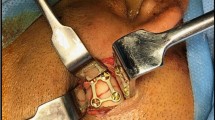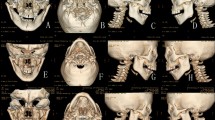Abstract
Objective
This study was conducted with the aim to establish standard technique of closed reduction (CR) and compare functional outcomes in patients of moderately displaced unilateral extracapsular condylar fractures.
Material and methods
This study is a retrospective randomized controlled trial, conducted at a tertiary care hospital setting from August, 2013 to November, 2018. Patients of unilateral extracapsular condylar fractures with ramus shortening < 7mm and deviation < 35° were divided in two groups by drawing lots and were treated by dynamic elastic therapy and maxillomandibular fixation (MMF). Mean and standard deviation were calculated for quantitative variables, and one way analysis of variance (ANOVA) and Pearson’s Chi-square test were used to determine significance of outcomes between two modalities of CR. P value < 0.05 was taken as significant.
Results
The numbers of patients treated by dynamic elastic therapy and MMF were 76 (38 in each group). Out of which 48 (63.15%) were male and 28 (36.84%) were female. The ratio of male to female was 1.7:1. The mean ± standard deviation (SD) of age was 32 ± 9.57 years. In patients treated by dynamic elastic therapy, the mean ± SD (at 6-month follow-up) of loss of ramus height (LRH), maximum incisal opening (MIO) and opening deviation were 4.6mm ± 1.08mm, 40.4mm ± 1.57mm and 1.1mm ± 0.87mm respectively. Whereas, LRH, MIO and opening deviation were 4.6mm ± 0.85mm, 40.4mm ± 2.37mm and 0.8mm ± 0.63mm respectively by MMF therapy. One-way ANOVA was statistically insignificant (P value > 0.05) for above mentioned outcomes. Pre-traumatic occlusion was achieved in 89.47% of patients by MMF and in 86.84% patients by dynamic elastic therapy. Pearson’s Chi-square test was statistically insignificant (p value < 0.05) for occlusion.
Conclusion
Parallel results were obtained for both modalities; thus, the technique as dynamic elastic therapy, which promotes early mobilization and functional rehabilitation, can be favored as standard technique of closed reduction for moderately displaced extracapsular condylar fractures. This technique eases patients’ stress associated with MMF and prevents ankylosis.
Similar content being viewed by others
References
Shah N, Patel S, Sood R, Mansuri Y, Gamit M, Rupawala T (2019) Analysis of mandibular fractures: a 7-year retrospective study. Ann Maxillofac Surg 9(2):349–354. https://doi.org/10.4103/ams.ams_22_19
Afrooz PN, Bykowski MR, James IB, Daniali LN, Clavijo-Alvarez JA (2015) The epidemiology of mandibular fractures in the United States, Part 1: A review of 13,142 cases from the US National Trauma Data Bank. J Oral Maxillofac Surg 73(12):2361–2366. https://doi.org/10.1016/j.joms.2015.04.032
Chang SP, Yang Y, Shi LQ, Liu YW, Liu Y, Ma Q (2018) Modification of the measurement of the major variables in mandibular condylar fractures: angulation of sidewards displacement and shortening of the height of the ramus. Br J Oral Maxillofac Surg 56(2):113–119. https://doi.org/10.1016/j.bjoms.2017.12.003
Neff A, Cornelius C-P, Rasse M, Torre D, Audigé L (2014) The comprehensive AOCMF classification system: condylar process fractures—level 3 tutorial. Craniomaxillofac Trauma Reconstr 7(1_suppl):44–58. https://doi.org/10.1055/s-0034-1389559
Choi K-Y, Yang J-D, Chung H-Y, Cho B-C (2012) Current concepts in the mandibular condyle fracture management Part I: Overview of condylar fracture. Arch Plast Surg 39(04):291–300. https://doi.org/10.5999/aps.2012.39.4.291
Sawazaki R, Lima Júnior SM, Asprino L, Moreira RWF, de Moraes M (2010) Incidence and patterns of mandibular condyle fractures. J Oral Maxillofac Surg 68(6):1252–1259. https://doi.org/10.1016/j.joms.2009.03.064
Fama F et al (2017) Maxillofacial and concomitant serious injuries: an eight-year single center experience. Chin J Traumatol 20(1):4–8. https://doi.org/10.1016/j.cjtee.2016.11.003
Al-Moraissi EA, Ellis E (2015) Surgical treatment of adult mandibular condylar fractures provides better outcomes than closed treatment: a systematic review and meta-analysis. J Oral Maxillofac Surg 73(3):482–493. https://doi.org/10.1016/j.joms.2014.09.027
Madadian MA, Simon S, Messiha A (2020) Changing trends in the management of condylar fractures. Br J Oral Maxillofac Surg 58(9):1145–1150. https://doi.org/10.1016/j.bjoms.2020.07.035
Rozeboom A, Dubois L, Bos R, Spijker R, de Lange J (2017) Open treatment of unilateral mandibular condyle fractures in adults: a systematic review. Int J Oral Maxillofac Surg 46(10):1257–1266. https://doi.org/10.1016/j.ijom.2017.06.018
Rozeboom AVJ, Dubois L, Bos RRM, Spijker R, de Lange J (2017) Closed treatment of unilateral mandibular condyle fractures in adults: a systematic review. Int J Oral Maxillofac Surg 46(4):456–464. https://doi.org/10.1016/j.ijom.2016.11.009
Neff A (2019) Open reduction and internal fixation in temporomandibular joint traumatology: current concepts and future perspectives. SDS 2019. https://doi.org/10.20517/2573-0002.2018.27
Ganesh Sriraam K, Vignesh KRA (2021) Diagnosis and management of mandibular condyle fractures. In: Sridharan G (ed) Oral and maxillofacial surgery. IntechOpen. https://doi.org/10.5772/intechopen.93795
Karan A et al (2019) Condylar fractures: Surgical versus conservative management. Ann Maxillofac Surg 9(1):15. https://doi.org/10.4103/ams.ams_157_17
Merlet F-L et al (2018) Outcomes of functional treatment versus open reduction and internal fixation of condylar mandibular fracture with articular impact: a retrospective study of 83 adults. J Stomatol Oral Maxillofac Surg 119(1):8–15. https://doi.org/10.1016/j.jormas.2017.10.007
Asim MA, Ibrahim MW, Javed MU, Zahra R, Qayyum MU (2019) Functional outcomes of open versus closed treatment of unilateral mandibular condylar fractures. J Ayub Med Coll Abbottabad 31(1):67–71
Vincent AG, Ducic Y, Kellman R (2019) Fractures of the mandibular condyle. Facial Plast Surg 35(06):623–626. https://doi.org/10.1055/s-0039-1700888
Manuel MLB, Prabhu D Complications of unilateral condylar fracture. IJRTI 6(3):49–54 Available: http://www.ijrti.org/papers/IJRTI2103011.pdf
Nitzan DW, Palla S (2017) ‘Closed reduction’ principles can manage diverse conditions of temporomandibular joint vertical height loss: from displaced condylar fractures to idiopathic condylar resorption. J Oral Maxillofac Surg 75(6):1163.e1–1163.e20. https://doi.org/10.1016/j.joms.2017.01.037
Palmieri C, Ellis E III, Throckmorton G (1999) Mandibular motion after closed and open treatment of unilateral mandibular condylar process fractures. J Oral Maxillofac Surg 57:764–776
Yanez-Vico RM, Iglesias-Linares A, Torres-Lagares D, Gutierrez-Perez JL, Solano-Reina E (2010) Diagnostic of craniofacial asymmetry. Literature review. Med Oral:e494–e498. https://doi.org/10.4317/medoral.15.e494
“ICH Expert Working Integrated addendum to ICH E6 (R1): guideline for good clinical practice E6 (R2).” Jun. 11, 2015.
Larheim TA, Svanaes DB, Johannessen S (1984) Reproducibility of radiographs with the orthopantomograph 5: tooth-length assessment. Oral Surg Oral Med Oral Pathol 58(6):736–741. https://doi.org/10.1016/0030-4220(84)90045-8
Eckelt U et al (2006) Open versus closed treatment of fractures of the mandibular condylar process—a prospective randomized multi-centre study. J Craniomaxillofac Surg 34(5):306–314. https://doi.org/10.1016/j.jcms.2006.03.003
Naik K, Lee KC, Torroni A (2020) Does open reduction and internal fixation provide a quality-of-life benefit over traditional closed reduction of mandibular condyle fractures? J Oral Maxillofac Surg 78(11):2018–2026. https://doi.org/10.1016/j.joms.2020.07.014
Frattali C (1998) Assessing functional outcomes: an overview. Semin Speech Lang 19(03):209–221. https://doi.org/10.1055/s-2008-1064045
Han X, Shao X, Lin X, Gui W, Zhang M, Liang L (2020) Open surgery versus closed treatment of unilateral mandibular condyle fractures. J Craniofac Surg 31(2):484–487. https://doi.org/10.1097/SCS.0000000000006080
Rastogi S, Sharma S, Kumar S, Reddy MP, Niranjanaprasad Indra B (2015) Fracture of mandibular condyle—to open or not to open: an attempt to settle the controversy. Oral Surg Oral Med Oral Pathol Oral Radiol 119(6):608–613. https://doi.org/10.1016/j.oooo.2015.01.012
Danda AK, Muthusekhar MR, Narayanan V, Baig MF, Siddareddi A (2010) Open versus closed treatment of unilateral subcondylar and condylar neck fractures: a prospective, randomized clinical study. J Oral Maxillofac Surg 68(6):1238–1241. https://doi.org/10.1016/j.joms.2009.09.042
Rozeboom AVJ et al (2018) Clinical outcomes in the treatment of unilateral condylar fractures: a cross-sectional study. Int J Oral Maxillofac Surg 47(9):1132–1137. https://doi.org/10.1016/j.ijom.2018.05.021
Kamel GN, De Ruiter BJ, Baghdasarian D, Mostafa E, Levin A, Davidson EH (2019) Establishing a protocol for closed treatment of mandibular condyle fractures with dynamic elastic therapy. Plast Reconstr Surg Glob Open 7(12):e2506. https://doi.org/10.1097/GOX.0000000000002506
Lee J-S et al (2014) Anatomical and functional recovery of intracapsular fractures of the mandibular condyle: analysis of 124 cases after closed treatment. Maxillofac Plast Reconstr Surg 36(6):259–265. https://doi.org/10.14402/jkamprs.2014.36.6.259
Vernhet E, De Boutray M, Hoarau R, Jammet P, Galmiche S, Breton I (2019) Exclusive functional treatment for mandibular condylar fractures. J Oral Maxillofac Surg 77(12):2523.e1–2523.e8. https://doi.org/10.1016/j.joms.2019.06.188
Kobayashi T et al (2021) Identification of malocclusion risk factors after closed treatment of condylar fractures using a novel three-dimensional computed tomography approach. J Oral Sci 63(3):283–285. https://doi.org/10.2334/josnusd.20-0600
Singh V, Bhagol A, Goel M, Kumar I, Verma A (2010) Outcomes of open versus closed treatment of mandibular subcondylar fractures: a prospective randomized study. J Oral Maxillofac Surg 68(6):1304–1309. https://doi.org/10.1016/j.joms.2010.01.001
Khiabani K, Zinhaghayegh B, Amirzade-Iranaq MH (2021) Does dynamic intermaxillary fixation with elastics improve outcomes following unilateral condylar fracture? J Oral Maxillofac Surg 79(1):192–199. https://doi.org/10.1016/j.joms.2020.08.040
Nogami S, Yamauchi K, Kataoka Y, Takano H, Yamashita Y, Takahashi T (2014) Clinical comparison between arthrocentesis and conventional conservative treatment with maxillomandibular fixation for unilateral high condylar fractures. J Oral Rehabil 41(2):141–147. https://doi.org/10.1111/joor.12124
Sforza C, Ugolini A, Sozzi D, Galante D, Mapelli A, Bozzetti A (2011) Three-dimensional mandibular motion after closed and open reduction of unilateral mandibular condylar process fractures. J Craniomaxillofac Surg 39(4):249–255. https://doi.org/10.1016/j.jcms.2010.06.005
De Riu G, Gamba U, Anghinoni M, Sesenna E (2001) A comparison of open and closed treatment of condylar fractures: a change in philosophy. Int J Oral Maxillofac Surg 30(5):384–389. https://doi.org/10.1054/ijom.2001.0103
Shen L, Li P, Li J, Long J, Tian W, Tang W (2014) Management of superolateral dislocation of the mandibular condyle: a retrospective study of 10 cases. J Craniomaxillofac Surg 42(1):53–58. https://doi.org/10.1016/j.jcms.2013.02.002
Niezen ET, Stuive I, Post WJ, Bos RRM, Dijkstra PU (2015) Recovery of mouth-opening after closed treatment of a fracture of the mandibular condyle: a longitudinal study. Br J Oral Maxillofac Surg 53(2):170–175. https://doi.org/10.1016/j.bjoms.2014.11.007
Niezen ET, Bos RRM, de Bont LGM, Stegenga B, Dijkstra PU (2010) Complaints related to mandibular function impairment after closed treatment of fractures of the mandibular condyle. Int J Oral Maxillofac Surg 39(7):660–665. https://doi.org/10.1016/j.ijom.2010.03.015
Anyanechi CE (2015) Temporomandibular joint ankylosis caused by condylar fractures: a retrospective analysis of cases at an urban teaching hospital in Nigeria. Int J Oral Maxillofac Surg 44(8):1027–1033. https://doi.org/10.1016/j.ijom.2015.05.003
Author information
Authors and Affiliations
Contributions
All authors contributed to study conception and design. Material preparation and data collection were performed by FAC, FA and TR. Data analysis and first draft of manuscript was written by SM. Critical review was done by AS and NZ. All authors commented on previous versions of the manuscript. All authors read and approved the final manuscript.
Corresponding author
Ethics declarations
Ethics approval
This study was performed in line with the principles of the Declaration of Helsinki. Approval was granted by the Ethics Committee of Lahore Medical & Dental College (reference no. LMDC/FD/1826/12).
Consent to participate
Written informed consent was obtained from all individual participants included in the study.
Consent for publication
This study does not contain any individual person’s data in any form (including individual details, images or videos).
Competing interests
The authors declare no competing interests.
Additional information
Publisher’s note
Springer Nature remains neutral with regard to jurisdictional claims in published maps and institutional affiliations.
Rights and permissions
Springer Nature or its licensor (e.g. a society or other partner) holds exclusive rights to this article under a publishing agreement with the author(s) or other rightsholder(s); author self-archiving of the accepted manuscript version of this article is solely governed by the terms of such publishing agreement and applicable law.
About this article
Cite this article
Sohail, A., Chishti, F.u.d.A., Manzar, S. et al. Can dynamic elastic therapy be established as the standard protocol of closed reduction for moderately displaced extracapsular condylar fractures?. Oral Maxillofac Surg 28, 385–391 (2024). https://doi.org/10.1007/s10006-023-01154-6
Received:
Accepted:
Published:
Issue Date:
DOI: https://doi.org/10.1007/s10006-023-01154-6




